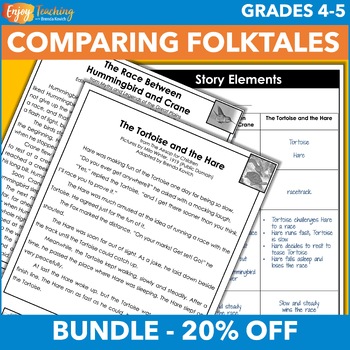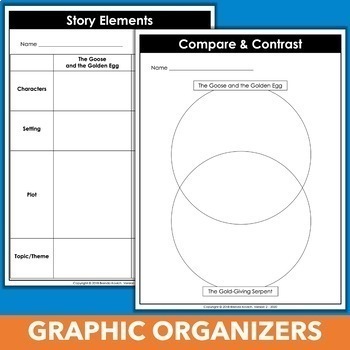Comparing Folktales Around the World Unit - 4th & 5th Grade Bundle RL.4.9 RL.5.9
- Zip
- Internet Activities
- Easel Activity
What educators are saying
Products in this Bundle (5)
Bonus
Description
Explore similar themes and topics in folktales from around the world. Three instructional slideshows, posters, fourteen paired passages, and graphic organizers provide a complete, differentiated ELA unit. Fourth and fifth grade students learn to identify characters, setting, plot, and theme; find similarities and differences; and write a paragraph to compare and contrast literature from different cultures.
Open the previews to get a closer look.
First, introduce students to types of folklore.
- A slideshow presents definitions, examples, and elements of myths, legends, fairy tales, fables, and tall tales.
- Printable posters provide reinforcement.
Second, provide direct instruction and modeling of comparing and contrasting literature.
- Kids watch two videos, "The Grasshopper and the Ants" and "The Grasshopper and the Ants."
- A basic slideshow models the process for identifying story elements, organizing them in a table, analyzing with a Venn diagram, and writing a compare-contrast paragraph.
- A parallel slideshow provides a higher-level option. Students identify archetypes and use them to compare stories.
Third, offer guided practice.
- Students read "Mani and Sol" and "The Fire Dog."
- They list elements on tables, compare, and write paragraphs to explain.
Now it's time for some independent practice.
- Six additional pairs of passages provide plenty of practice. (It's important to recognize that this process is hard work. Therefore, spreading them out over time is suggested.)
Finally, assess student learning.
- One more set of stories may be used as a test.
- Rubrics support both formative and summative assessment.
Fourteen folktales from different regions of the world were carefully selected and adapted.
- “Mani and Sol” (Norway) and “The Fire Dog” (Korea)
- “The Goose and the Golden Egg” (Samoa) and “The Gold-Giving Serpent” (India)
- “The Talking Eggs” (United States) and “Cinderella” (France)
- “Yorimasa” (Japan) and “The Dreadful Gorgon” (Greece)
- “Hummingbird and Crane” (United States) and “The Tortoise and the Hare” (Samoa)
- Bonus: "The Peacock" and "The Town Mouse and the Country Mouse"
- Bonus: "The Boy Who Cried Wolf" and "The Donkey and the Load of Salt"
You can differentiate to meet the needs of all students in your class.
- Remedial - Read and discuss paired folklore together. Ask students to identify characters, setting, and plot then write a one-paragraph response.
- Basic - Ask students to read stories independently; identify characters, setting, plot, and theme; and write a one-paragraph response.
- Advanced - Ask students to read stories independently; identify characters, setting, plot, and theme; determine archetype for each; and write a longer response (one or more paragraphs).
You'll love using these resources with your class or homeschool!
- Slideshows allow you to teach with confidence.
- Literature can be used to compare and contrast - or for an activity of your choice. You'll use them year after year.
- Processes support fourth and fifth grade standards, such as CCSS 4.9 and 5.9; Texas TEKS LA.4.7.B, LA.4.9.A, LA.5.7.B, LA.5.9.A; and Virginia VA SOL.R.4.5.d, R.4.5.i, R.5.5.f, and R.5.5.l.
- Support materials encourage higher-order thinking skills and allow your students to complete complex tasks with ease.
You can choose from formats that best match your teaching style.
- Passages and worksheets may be used as printable PDFs, customized Easel Activities, or forced Google Slides.
- Slideshows are included in two formats: PowerPoint and Google Slides.
Enjoy teaching folktales!
Brenda Kovich
Stories were adapted from literature in the public domain.





